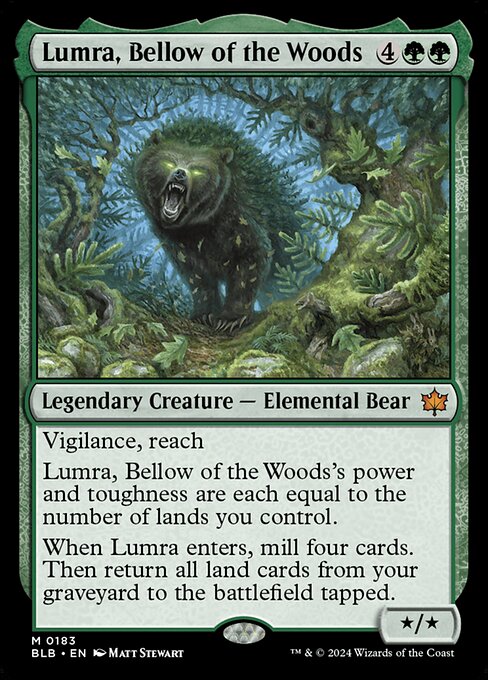
Image courtesy of Scryfall.com
Lumra, Bellow of the Woods: Collector vs Regular Edition Value
Green lovers, stampede your forests and watch the green mana glow as Lumra, Bellow of the Woods strides onto the battlefield. This mythic Legend from Bloomburrow (BLB) isn't just a big body with green ambitions; it's a strategic engine that scales with your land drops and winks at graveyard shenanigans. With a mana cost of 4GG, Lumra demands a sizable commitment, but what you get in exchange is a dynamic, game-shifting presence 🧙🔥💎. In collector circles, the question often becomes: how does the value of a foil collector edition compare to the regular print, and what does that mean for modern and commander games alike? The answer is as green as Lumra’s fervent forests—and just as layered.
Card profile: what Lumra actually does
- Name: Lumra, Bellow of the Woods
- Set: Bloomburrow (BLB)
- Type: Legendary Creature — Elemental Bear
- Mana cost: {4}{G}{G} (six mana total)
- Rarity: Mythic
- Colors: Green
- Keywords: Reach, Vigilance, Mill
- Oracle text: Vigilance, reach. Lumra's power and toughness are each equal to the number of lands you control. When Lumra enters, mill four cards. Then return all land cards from your graveyard to the battlefield tapped.
In practice, Lumra becomes a colossal threat as your number of lands grows. Its power and toughness scale with your board, turning every new land into a potential plus. The enter-the-battlefield mill four cards adds graveyard synergy right away, which you can leverage with land-focused recursion over the next turns. And that last line—returning all land cards from your graveyard to the battlefield tapped—opens up explosive landfall opportunities and potential identity shifts, especially in ramp-heavy decks. All of this lands you squarely in the realm of big green synergy, where tempo is built on acceleration and payoff is measured in ownership of the battlefield and the card pool you millled into action 🎲⚔️.
Collector edition vs regular edition: what the numbers say
So, how does Lumra’s value differ between collector (foil) and regular (non-foil) editions? The modern market for this Bloomburrow mythic is a good barometer for the collector-foil premium. In U.S. dollars, the data trend lines show non-foil Lumra around $28.72, while foil versions sit a touch higher at about $31.85. In euro terms, non-foil hovers near €25.41 and foil reaches roughly €32.51. Those differentials aren’t gigantic, but they do reflect the classic premium attached to foil presentations in a current set—the kind of premium that compels collectors to chase that glimmering border and a shinier surface 🧙🔥💎.
What does that mean for “Collector Edition” value specifically? In many MTG contexts,Collector editions refer to special foil runs found in Collector Boosters or premium product lines that emphasize rare, foil, or alternate-foil treatments. Lumra’s foil print in modern sets tends to command higher liquidity and desirability among EDH players who prize high-impact visuals and tactile collectability. However, because Lumra is a regular, non-foil print in standard boosters as well, you’re looking at a straightforward price delta: a foil copy is typically the premium option within the same print run, not a separate, vastly rarer edition. The collector mindset—pulling a foil you can sleeve and play or flipping it for a bump in value—creates a practical, if modest, premium that green decks often reward with their demand for big, land-powering creatures 🧙🔥🎨.
In practice, the real “collector value” for Lumra also hinges on playability and demand. EDH commanders love to scale Lumra up with the number of lands in play, creating late-game inevitabilities that are thrilling to watch unfold. The art by Matt Stewart, the dramatic presence on the card, and the glow of a mythical green behemoth make Lumra a favorite for collectors who also enjoy actually playing their cards. The synergy with land-based strategies and a graveyard-to-battlefield angle makes Lumra a standout in green-centric lineups, both in terms of surface appeal and strategic depth 🧙🔥💎.
Why players might choose regular over collector—and vice versa
Choosing between foil and non-foil Lumra often comes down to table presence, budget, and how you value resale liquidity. A foil Lumra can give your deck a little extra pop in multiplayer settings, where big creatures and bold arts are part of the spectacle. On the other hand, a non-foil Lumra is a solid choice for budget-conscious players who want the power of this ability without the premium attached to a foil print. Collectors often track print runs and the availability of foil reprints; for Lumra, that premium is present but not extreme, which can make both options appealing depending on your collection strategy and playing style 🧙🔥⚔️.
For builders curious about the broader market, the price snapshots show the trend: a few dollars separate foil from non-foil, while the value in competitive formats comes more from the card’s in-game potential and the demand from Commander players who prize land ramp and graveyard manipulation. With Lumra, you’re buying not just a card, but a gateway to long-term strategic identity in green shells—the kind of card that can become a perennial favorite across formats 🎨🎲.
Neon phone case with card holder magsafe polycarbonate glossy matteMore from our network
- https://blog.digital-vault.xyz/blog/post/griffin-riders-influence-on-mtg-fan-card-design/
- https://blog.digital-vault.xyz/blog/post/security-first-product-design-build-resilience-from-day-one/
- https://blog.digital-vault.xyz/blog/post/burning-sun-cavalry-sparks-fan-made-mtg-card-design/
- https://transparent-paper.shop/blog/post/digital-paper-in-ai-art-prompts-techniques-and-trends/
- https://crypto-acolytes.xyz/blog/post/how-to-build-a-home-arcade-cabinet-a-diy-guide/